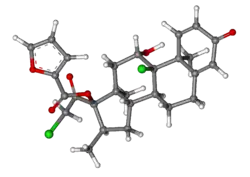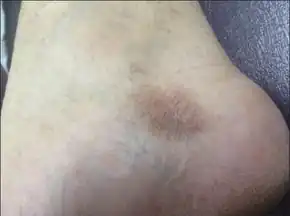Mometasone
 | |
 | |
| Names | |
|---|---|
| Trade names | Nasonex, Asmanex, Elocon, others[1] |
| Other names | LAS-41002, 9α,21-Dichloro-11β,17α-dihydroxy-16α-methylpregna-1,4-diene-3,20-dione 17α-(2-furoate) |
IUPAC name
| |
| Clinical data | |
| Drug class | Corticosteroid; glucocorticoid |
| WHO AWaRe | UnlinkedWikibase error: ⧼unlinkedwikibase-error-statements-entity-not-set⧽ |
| Pregnancy category | |
| Routes of use | Topical, inhalation (nasal spray) |
| Defined daily dose | 0.2 mg (nose)[3] 0.4 mg (inhaled)[4] |
| External links | |
| AHFS/Drugs.com | Main: Monograph Nose: Monograph Topical: Monograph |
| Legal | |
| License data |
|
| Legal status |
|
| Pharmacokinetics | |
| Bioavailability | Nasal spray is virtually undetectable in plasma; but systemic availability is comparable to fluticasone[5] |
| Protein binding | 98% to 99% |
| Metabolism | Liver |
| Elimination half-life | 5.8 hours |
| Chemical and physical data | |
| Formula | C22H28Cl2O4 for mometasone C27H30O6Cl2 as furoate |
| Molar mass | 427.361 g/mol (mometasone) 521.4 g/mol (furoate) |
| 3D model (JSmol) | |
SMILES
| |
InChI
| |
Mometasone, also known as mometasone furoate, is a steroid medication used to treat certain skin conditions, hay fever, and asthma.[6][7][8] Specifically it is used to prevent rather than treat asthma attacks.[6] It can be applied to the skin, inhaled, or used in the nose.[6][7][8] Mometasone furoate, not mometasone is used in medical products.[9]
Common side effects when used for asthma include headache, sore throat, and thrush.[6] It is therefore recommended to rinse the mouth after use.[6] Long term use may increase the risk for glaucoma and cataracts.[6] Common side effects when used in the nose includes upper respiratory tract infections and nose bleeds.[8] Common side effects when applied on the skin include acne, skin atrophy, and itchiness.[7] It works by decreasing inflammation.[6]
Mometasone furoate was patented in 1981 and came into medical use in 1987.[10] It is on the World Health Organization's List of Essential Medicines as an alternative to budesonide.[11] It is available as a generic medication.[12] A month supply of the inhaler in the United Kingdom costs the NHS about £30 while the nasal spray is less than £2, as of 2019.[12] In 2017, it was the 197th most commonly prescribed medication in the United States, with more than two million prescriptions.[13][14]
Medical uses
Mometasone furoate is used in the treatment of inflammatory skin disorders (such as eczema and psoriasis) (topical form), allergic rhinitis (such as hay fever) (topical form), asthma (inhalation form)[15][16] for people unresponsive to less potent corticosteroids, and penile phimosis.[17] In terms of steroid strength, it is more potent than hydrocortisone, and less potent than dexamethasone.[18]
Some low-quality evidence suggests the use of mometasone for symptomatic improvement in children with adenoid hypertrophy.[19]
Mometasone is used to alleviate inflammation and itchiness in skin conditions that respond to treatment with glucocorticoids such as psoriasis and atopic dermatitis.[20][21]
Nasal mometasone is used in adults (including the elderly) and children over two years of age, to diminish the symptoms such as hay fever (seasonal allergic rhinitis) and other allergies (perennial rhinitis), including nasal congestion, discharge, pruritus, and sneezing and to treat nasal polyps.[22]
It is not useful for the common cold.[23]
Asthma
Mometasone furoate can be used with formoterol for the treatment of asthma, due to its anti-inflammatory properties.[19][24]
Dosage
The defined daily dose is 0.2 mg in the nose,[3] or 0.4 mg inhaled.[4]
Contraindications
People should not use inhaled mometasone or mometasone nasal spray if:
- glaucoma or cataracts
- hypersensitivity or allergic to any ingredient in mometasone
Those who are using mometasone nasal or inhaled for a long period of time (e.g. more than three months) should get regular eye exams to check for glaucoma and cataracts and should take precautions to avoid infections such as taking a vitamin D supplement, staying away from those with an infection (chickenpox, measles, colds or flu), washing foods, hand washing and calling a family doctor at the first sign of a severe infection.
People should not use mometasone topical (skin cream) if:
- hypersensitive or allergic to any ingredient in the skin cream
Mometasone furoate is in class C in terms of safety while use during pregnancy. Therefore, its risks to the baby cannot be ruled out. Therefore, the use in pregnancy is not recommended.
Side effects

The nasal spray form of mometasone may cause the following side effects:
- headache
- Viral upper respiratory infections
- sore throat
- nose bleeds
- cough
- muscle and joint pain
Serious side effects include: Thrush (fungal infection in the nose or throat), slow wound healing, eye problems such as glaucoma or cataracts, weakened immune system (immunodeficiency) which causes an increased susceptibility to infections and adrenal insufficiency.
The inhaled form of mometasone for asthma may cause the following side effects
- headache
- stuffy or runny nose
- dry throat
- swelling of nose, throat and sinuses
- flu like symptoms
- painful menstrual periods
Serious side effects may include : allergic reactions (anaphylaxis), increased risk of osteoporosis, glaucoma and cataracts, thrush in the mouth or throat, growth retardation in children, bronchospasms, adrenal insufficiency and weakened immune system which causes an increased susceptibility to infections.
The topical (skin cream) version may cause:
- burning and itching at the application site
- acne
- changes in skin color
- dryness at application site
- skin sores
The only serious side effect that is known with mometasone topical is adrenal insufficiency.
Pharmacology
Pharmacodynamics
Mometasone furoate reduces inflammation by causing several effects:[22][25][26]
- Reversing the activation of inflammatory proteins
- Activating the secretion of anti-inflammatory proteins
- Stabilizing cell membranes
- Decreasing the influx of inflammatory cells
In addition to the glucocorticoid properties of mometasone furoate, it is a very potent agonist of the progesterone receptor as well as a partial agonist of the mineralocorticoid receptor.[27]
Mechanism of action

Mometasone, like other corticosteroids, possesses anti-inflammatory, antipruritic, and vasoconstrictive properties. For allergies, corticosteroids reduce the allergic reactions in various types of cells (mastocytes and eosinophils) that are responsible for allergic reactions. Mometasone and other corticosteroids circulate in the blood easily, crossing cellular membranes and binding with cytoplasmic receptors, resulting in the transcription and synthesis of proteins. It also inhibits the actions of the enzyme cytochrome P450 2C8 which participates in the activity of monooxygenase.[28]
The inflammation is reduced in decreasing the liberation of hydrolase acids of leukocytes, the prevention of the accumulation macrophages in the sites of inflammation, the interference with adhesion of leukocytes to capillary walls, the reduction of the permeability of the capillary membranes and consequently edema, the reduction of complementary components, inhibition of histamine and kinin liberation, and interference with scar tissue formation.[29] The proliferation of fibroblasts and collagen deposits is also reduced. It is believed that the action of corticosteroid anti-inflammatory agents is bound to inhibitive proteins of phospholipase A2, collectively called lipocortins. The lipocortins, in turn, control the biosynthesis of potent mediators of inflammation as the prostaglandins and leukotrienes, inhibiting the liberation of the molecular precursors of arachidonic acid. Intranasal mometasone alleviates symptoms such as rhinorrhea aquosa, nasal congestion, nasal drip, sneezing, and pharyngeal itching. Topical administration applied to skin reduces the inflammation associated with chronic or acute dermatosis.
Although mometasone furoate does not have significant systemic immunomodulatory effects, it can be considered a local immunosuppressive drug because clinical studies have shown reductions (vs. baseline ) in neutrophils (a white blood cell) in the nasal mucosa. It could be also considered an antihistamine along with its glucocorticoid effects because it significantly reduces histamine and eosinophil cationic protein levels.
Pharmacokinetics
Metabolism
Extensive metabolic hepatic metabolism of mometasone furoate to multiple metabolites occurs. No principal metabolites are detectable in plasma. After in vitro incubation, one of the minor metabolites formed is furoate 6β-hydroxymometasone. In human hepatic microsomes, the formation of these metabolites is regulated by CYP3A4.[22]
Mometasone
Mometasone by itself is a synthetic, steroidal glucocorticoid or corticosteroid that was never marketed.[30][31][32] The C17α furoate ester of mometasone, is the marketed medication.[30][31][32] Mometasone furoate acts as a prodrug of mometasone.[33] In addition to its glucocorticoid activity, mometasone also has very potent progestogenic activity and acts as a partial agonist of the mineralocorticoid receptor.[27]
Society and culture
Cost
A month supply of the inhaler in the United Kingdom costs the NHS about £30 while the nasal spray is less than £2, as of 2019.[12] In 2017, it was the 197th most commonly prescribed medication in the United States, with more than two million prescriptions.[13][14]
.svg.png.webp) Mometasone costs (US)
Mometasone costs (US).svg.png.webp) Mometasone prescriptions (US)
Mometasone prescriptions (US)
Brand names
As of 2016 mometasone furoate was available worldwide in formulations for nasal, oral inhalation, and topical administration, for human and for veterinary use, and in combinations with other drugs, under many brand names.[1]
It was available As of 2016, as the single active agent in the following brands: Alcom, Altosone, Asmanex, Atozon, Aureox, Belloseta, Bioelementa, Biometasona, Bloctimo, Borgasone, Breso, Broner, Codermo, Cortynase, Cutimom, Cutizone, Cutticom, Dance, Demoson, Dergentil, Derimod, Dermacortine, Dermaten, Dermome, Dermosona, Dermotasone, Dermovel, Desdek, Ecelecort, Ecural, Edelan, Elica, Elisone, Elisox, Elitasone, Elna, Elocan, Elocom, Elocon, Elocortin, Elofute, Elomet, Elomox, Eloskin, Eloson, Elosone, Elovent, Elox, Etacid, Eversone, Eztom, F-Din, Fenisona, Flazcort, Flogocort, Fremomet, Frondava, Fu Mei Song, Fulmeta, Furo, Furoato de Mometasona, Furoderm, Gistan-H, Honmet, Iflacort, Intercon, Ivoxel, Kalmente, Konex, Ladexol, Lisoder, Logren, Loksin, Lomeane, M-Furo, Makiren, Mefurosan, Melocort, Mena, Mesone, Metacortil, Metactiv, Metaflam, Metagra, Metasafe, Metason, Metasone, Metaspray, Metatop, Metaz, Metmin, Metsone, Midermin, Mifusin, Minyear, Mofacort, Mofulex, Mofur, Mofuroate, Molison, Momate, Momax, Momecon, Momecort, Momecutan, Momederm, MomeGalen, Momegen, Momekort, Momelab, Momentum, Momeplus, Momerid, Momeson, Momesone, Momester, Momet, Mometa, Mometagen, Mometason, Mometasona, Mometasona Furoato, Mometasone Furoate, Mometasone Furoate Hydrate, Mometasonfuroaat, Mometasonfuroat, Mometasoni furoas, Mometasonum, Mometasyn, Mometasyn, Mometax, Mometazon, Mometazona, Mometazona Fuorat, Mometazonfuroat, Mometix-AQ, Momevate, Momexa, Mommex, Mommox, Momtas, Monaliz, Monez, Monovel, Monovo, Mosone, Motaderm, Motaneal, Movesan, Mtaz, Mundoson, Murozo, Myrey, Narinex, Nasamet, Nasehaler, Nasocure, Nasomet, Nasometin, Nasonex, Nassomet, Nazofix, Nazoster, Netonox, Nexomist, Novasone, Ovison, Ovixan, Oximax, Pharmecort, Pluster, Pronasal, Propel, Prospiril, Pydercon, Rinelon, Rinitek, Rino-Val, Rinobudex, Rinonex, Rinosal, Rinosona, Rinoval, Risonel, Sensicort, Septopic, Silkaren, Soneta, Suavicort, Suqi, Synaller, Tabunex, Topcort, Topison, Uniclar, Uniderm, Vizomet, Yperod, Zalconex, and Zynovate.[1]
Combinations
The following combination drugs were available as of 2016:[1]
- Mometasone and azelastine as Nasaflex
- Mometasone and clotrimazole and gentamicin for veterinary use as Mometamax
- Mometasone and florfenicol and terbinafine for veterinary use as Claro
- Mometasone and formoterol as Dulera and Zenhale
- Mometasone and fusidic acid as Momate-F
- Mometasone and miconazole as Elica M and Sensicort-F
- Mometasone and mupirocin as Sensicort-B
- Mometasone and orbifloxacin and posaconazole for veterinary use as Posatex
- Mometasone and salicylic acid as Belosalic, Cortimax-S, Elicasal, Elocom Plus, Elosalic, Momate, Momesalic, Momtas, Monsalic, and Sensicort-S
- Mometasone and tazarotene as Tazasone Forte
- Mometasone and terbinafine as Cutizone-T
References
- 1 2 3 4 "International brands for Mometasone". Drugs.com. Archived from the original on 17 November 2016. Retrieved 17 November 2016.
- 1 2 "Mometasone Use During Pregnancy". Drugs.com. 14 February 2020. Archived from the original on 26 October 2020. Retrieved 1 April 2020.
- 1 2 "WHOCC - ATC/DDD Index". www.whocc.no. Archived from the original on 10 July 2021. Retrieved 7 September 2020.
- 1 2 "WHOCC - ATC/DDD Index". www.whocc.no. Archived from the original on 10 July 2021. Retrieved 7 September 2020.
- ↑ Zia R. Tayab; Tom C. Fardon; Daniel K. C. Lee; Kay Haggart; Lesley C. McFarlane; Brian J. Lipworth; Günther Hochhaus (November 2007). "Pharmacokinetic/pharmacodynamic evaluation of urinary cortisol suppression after inhalation of fluticasone propionate and mometasone furoate". Br J Clin Pharmacol. 64 (5): 698–705. doi:10.1111/j.1365-2125.2007.02919.x. PMC 2203259. PMID 17509041.
{{cite journal}}: Unknown parameter|last-author-amp=ignored (help) - 1 2 3 4 5 6 7 "Mometasone Furoate Monograph for Professionals". Drugs.com. American Society of Health-System Pharmacists. Archived from the original on 7 October 2016. Retrieved 11 March 2019.
- 1 2 3 "Mometasone Furoate topical Monograph for Professionals". Drugs.com. American Society of Health-System Pharmacists. Archived from the original on 5 August 2020. Retrieved 11 March 2019.
- 1 2 3 "Mometasone Furoate eent Monograph for Professionals". Drugs.com. American Society of Health-System Pharmacists. Archived from the original on 30 April 2016. Retrieved 11 March 2019.
- ↑ "Mometasone". DrugBank. Archived from the original on 29 June 2019. Retrieved 30 April 2020.
- ↑ Fischer, Jnos; Ganellin, C. Robin (2006). Analogue-based Drug Discovery. John Wiley & Sons. p. 488. ISBN 9783527607495. Archived from the original on 2020-02-18. Retrieved 2019-03-01.
- ↑ World Health Organization (2023). The selection and use of essential medicines 2023: web annex A: World Health Organization model list of essential medicines: 23rd list (2023). Geneva: World Health Organization. hdl:10665/371090. WHO/MHP/HPS/EML/2023.02.
- 1 2 3 British national formulary : BNF 76 (76 ed.). Pharmaceutical Press. 2018. p. 265. ISBN 9780857113382.
- 1 2 "The Top 300 of 2020". ClinCalc. Archived from the original on 12 February 2021. Retrieved 11 April 2020.
- 1 2 "Mometasone - Drug Usage Statistics". ClinCalc. Archived from the original on 27 January 2021. Retrieved 11 April 2020.
- ↑ Tan RA, Corren J (December 2008). "Mometasone furoate in the management of asthma: a review". Ther Clin Risk Manag. 4 (6): 1201–8. doi:10.2147/TCRM.S3261. PMC 2643101. PMID 19337427.
- ↑ Bousquet J (May 2009). "Mometasone furoate: an effective anti-inflammatory with a well-defined safety and tolerability profile in the treatment of asthma". Int. J. Clin. Pract. 63 (5): 806–19. doi:10.1111/j.1742-1241.2009.02003.x. PMID 19392928.
- ↑ Khope S (March 2010). "Topical mometasone furoate for phimosis". Indian Pediatr. 47 (3): 282. PMID 20371899.
- ↑ Williams, DM (2005). "What does potency actually mean for inhaled corticosteroids?". The Journal of Asthma. 42 (6): 409–17. doi:10.1081/jas-57878. PMID 16293535.
- 1 2 Passali, D; Spinosi, MC; Crisanti, A; Bellussi, LM (2 May 2016). "Mometasone furoate nasal spray: a systematic review". Multidisciplinary Respiratory Medicine. 11: 18. doi:10.1186/s40248-016-0054-3. PMC 4852427. PMID 27141307.
- ↑ Green, C; Colquitt, JL; Kirby, J; Davidson, P; Payne, E (November 2004). "Clinical and cost-effectiveness of once-daily versus more frequent use of same potency topical corticosteroids for atopic eczema: a systematic review and economic evaluation". Health Technology Assessment (Winchester, England). 8 (47): iii, iv, 1–120. doi:10.3310/hta8470. PMID 15527669.
- ↑ Prakash, A; Benfield, P (January 1998). "Topical mometasone. A review of its pharmacological properties and therapeutic use in the treatment of dermatological disorders". Drugs. 55 (1): 145–63. doi:10.2165/00003495-199855010-00009. PMID 9463794.
- 1 2 3 "Nasonex label" (PDF). FDA. January 2011. Archived (PDF) from the original on 2017-02-27. Retrieved 2016-11-17.
- ↑ "Mometasone Nasal Spray: MedlinePlus Drug Information". MedlinePlus. 2020-03-19. Archived from the original on 2020-03-20. Retrieved 2020-03-19.
Mometasone nasal spray should not be used to treat symptoms (e.g., sneezing, stuffy, runny, itchy nose) caused by the common cold. Mometasone nasal spray is in a class of medications called corticosteroids. It works by blocking the release of certain natural substances that cause allergy symptoms.
- ↑ Bousquet, J (May 2009). "Mometasone furoate: an effective anti-inflammatory with a well-defined safety and tolerability profile in the treatment of asthma". International Journal of Clinical Practice. 63 (5): 806–19. doi:10.1111/j.1742-1241.2009.02003.x. PMID 19392928.
- ↑ Publishers, Jones and Bartlett (2009-07-15). Nurse's Drug Handbook 2010. p. 677. ISBN 978-0-7637-7900-9.
- ↑ Mani S. Kavuru (2007). "ch. 9 Anti-inflammatory agents". Diagnosis and Management of Asthma. ISBN 978-1-932610-38-3.
- 1 2 Austin RJ, Maschera B, Walker A, Fairbairn L, Meldrum E, Farrow SN, Uings IJ (2002). "Mometasone furoate is a less specific glucocorticoid than fluticasone propionate". Eur. Respir. J. 20 (6): 1386–92. doi:10.1183/09031936.02.02472001. PMID 12503693.
- ↑ Walsky RL, Gaman EA, Obach RS (January 2005). "Examination of 209 drugs for inhibition of cytochrome P450 2C8". Journal of Clinical Pharmacology. 45 (1): 68–78. doi:10.1177/0091270004270642. PMID 15601807.
- ↑ Blaiss, MS (2011). "Safety update regarding intranasal corticosteroids for the treatment of allergic rhinitis". Allergy and Asthma Proceedings. 32 (6): 413–8. doi:10.2500/aap.2011.32.3473. PMID 22221434.
- 1 2 J. Elks (14 November 2014). The Dictionary of Drugs: Chemical Data: Chemical Data, Structures and Bibliographies. Springer. pp. 834–. ISBN 978-1-4757-2085-3. Archived from the original on 21 December 2016. Retrieved 11 March 2019.
- 1 2 Index Nominum 2000: International Drug Directory. Taylor & Francis. January 2000. pp. 701–. ISBN 978-3-88763-075-1. Archived from the original on 2019-12-15. Retrieved 2019-03-11.
- 1 2 I.K. Morton; Judith M. Hall (31 October 1999). Concise Dictionary of Pharmacological Agents: Properties and Synonyms. Springer Science & Business Media. pp. 185–. ISBN 978-0-7514-0499-9. Archived from the original on 21 December 2016. Retrieved 11 March 2019.
- ↑ Ruben Vardanyan; Victor Hruby (7 January 2016). Synthesis of Best-Seller Drugs. Elsevier Science. pp. 463–. ISBN 978-0-12-411524-8. Archived from the original on 15 December 2019. Retrieved 11 March 2019.
External links
| External sites: |
|
|---|---|
| Identifiers: |
|